CERF Blog
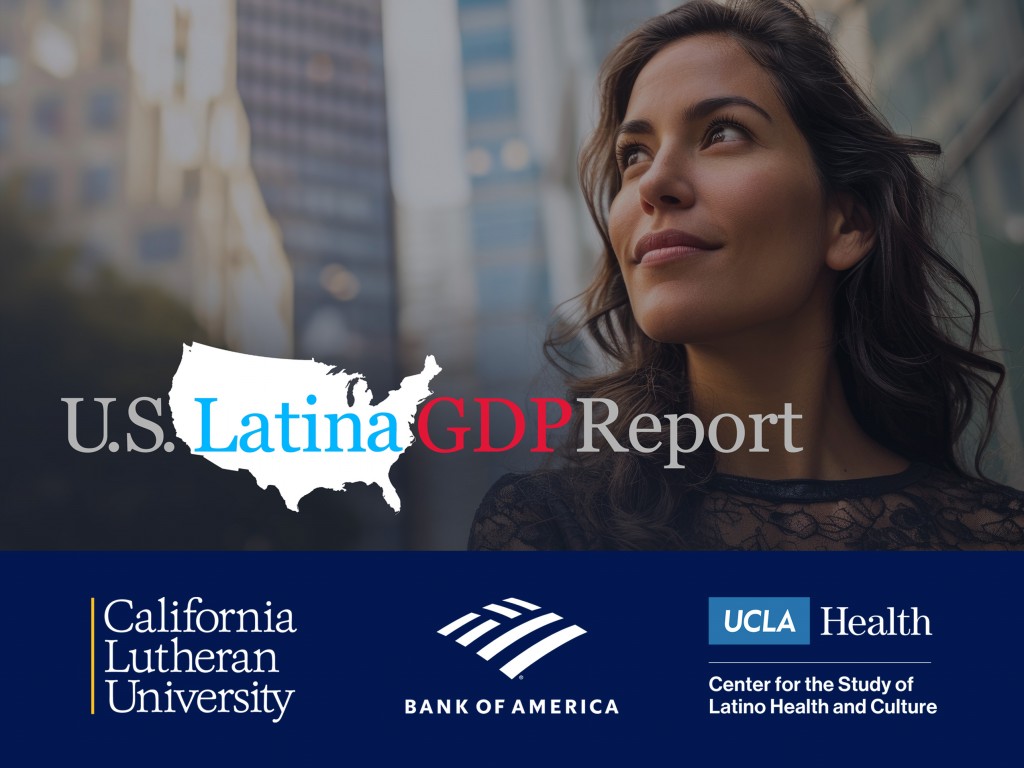
The Inaugural U.S. Latina GDP Report builds directly upon six annual U.S. Latino GDP Reports released since 2018 as well as eight State and a dozen Metro Latino GDP Reports written in partnership with Bank of America. Those reports provide a factual view of the large and rapidly growing economic contribution of Latinos living in the U.S. and document substantial economic growth premiums enjoyed relative to Non-Latinos. These premiums exist across a wide range of economic indicators, and Latino economic premiums are large – for example, U.S. Latino labor force growth is 9 times faster than Non-Latino labor force growth. U.S. Latino GDP growth is 2.4 times faster than Non-Latino GDP growth.
Analysis of U.S. Latinas reveals that, in almost every case, the economic growth premium enjoyed by Hispanics females is even larger than the already impressive premium for all Hispanics. It is not enough then to say that U.S. Latinas are drivers of economic growth and a critical source of resilience for the broader economy. They are drivers of economic vitality. U.S. Latinas are giving life to the U.S. economy, dando vida a la economía.
Dando Vida a la Economía | the Latina GDP
The 2021 U.S. Latina GDP is $1.3 trillion, up from $661 billion in 2010. The total economic output of Hispanic females in 2021 is larger than the entire economy of the state of Florida. In fact, only the GDPs of California, Texas and New York are larger than the U.S. Latina GDP.
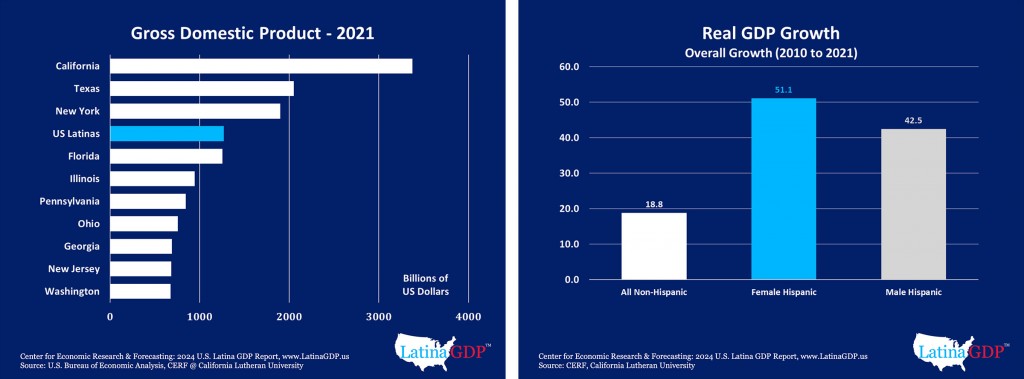
As with the broader Hispanic economy, while impressive for its size, the Latina GDP is truly remarkable for its rapid growth. From 2010 to 2021, the economic contribution of Latinas grew a total of 51.1 percent. Over this entire period, the real GDP of Hispanic females grew 1.2 times the rate of Hispanic males’ GDP and an astonishing 2.7 times the rate of Non-Hispanic GDP.
Educational Attainment
Dramatic growth of Latina GDP is driven by rapid gains in human capital. Educational attainment grew rapidly for Latinos of all genders from 2010 to 2021. During those years, the number of Hispanic females with a bachelor’s degree grew a total of 103.0 percent, while the number of highly educated Non-Hispanic females grew just 38.3 percent. In other words, over the entire period that we examine, Latina educational attainment grew 2.7 times that of Non-Hispanic females in the U.S.
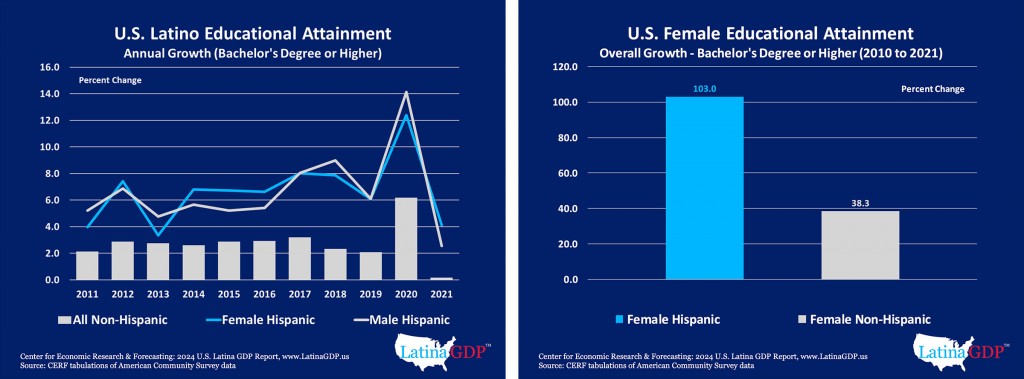
Labor Force Participation
Rapid growth of educational attainment is accompanied by strong labor force participation. The Latina labor force participation rate has grown steadily from 2000 to the present, adding 7.5 percentage points over two decades. During this same period, the labor force participation rate of Non-Hispanic females was essentially flat. The Latina labor force participation premium, relative to Non-Hispanic females, has grown steadily since 2010 and currently sits at an all-time high of 2.5 percentage points. Latinas, who started the century with a labor force participation rate a full 5.0 percentage points lower than Non-Hispanic females are now 2.5 percentage points more likely to be actively working than their Non-Hispanic female counterparts.
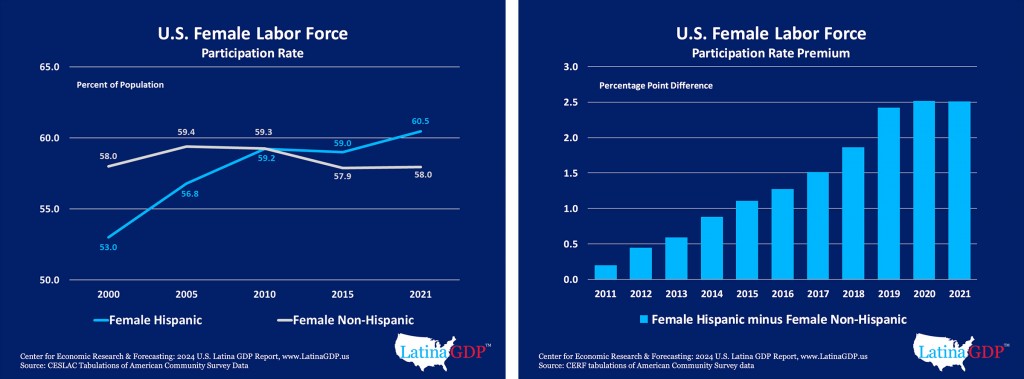
Income
Rapid gains in real income naturally flow from Latinas’ strong gains in human capital. While all Latino incomes grew strongly from 2010 to 2021, Hispanic females saw even stronger gains than Hispanic males. Compared to Non-Hispanic females, this income growth is especially noteworthy. From 2010 to 2021, the real incomes of Hispanic females grew a total of 46.0 percent compared to only 18.5 percent for Non-Hispanic females. In other words, Latinas enjoy an income growth rate that is 2.5 times that of their Non-Hispanic female counterparts.
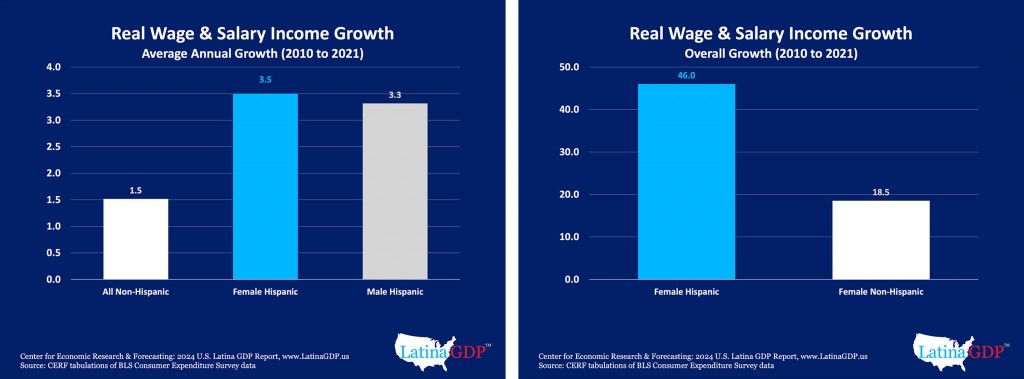
COVID-19 Pandemic and the Latina GDP
According to the dominant narrative, Latinos as a demographic cohort should have been knocked down by the COVID-19 pandemic. Yet, examining the impacts of COVID-19 through the lens of the Latino GDP reveals a very different narrative.
From the pre-pandemic peak of economic activity to 2021, real U.S. Latina GDP grew a total of 7.7 percent. This eclipses the 1.5 percent growth of Non-Hispanic GDP over the same period.
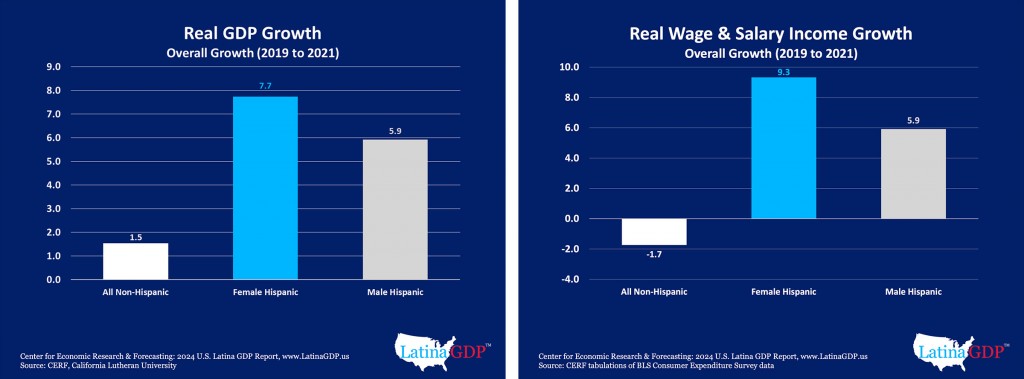
The strength of Latina GDP growth during the pandemic is consistent with the extraordinary growth of Latina incomes. Over the first two years of the COVID-19 pandemic, the real wage and salary income of U.S. Latinas increased a total of 9.3 percent, while Non-Hispanic income declined by a total of 1.7 percent. The extraordinary efforts of Latinas during the darkest days of the COVID-19 pandemic and throughout the economic recovery that followed gave life to the U.S. economy, at a time of desperate need.
Given the remarkable growth of the U.S. Latina GDP and other important trends outlined in this report, we expect that Latinas will continue to enjoy substantial growth premiums and provide greater vitality, giving life to the economy, dando vida a la economía, for the foreseeable future.
To access the full U.S. Latino GDP Report, please visit www.LatinaGDP.us

